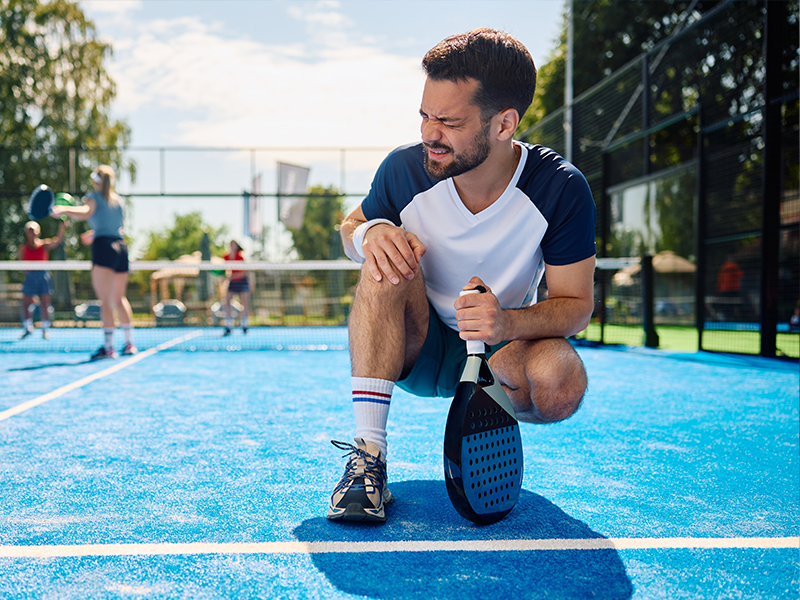Search
Find a Physician
Robert A. DeFalco, Jr., DO
Medically Reviewed by
William Sayde, MDBlog
Jul 2, 2025
When most people hear “sports injury,” their mind jumps straight to football collisions, MMA knockouts, or high-speed crashes on a racetrack. But the truth is, you’re far more likely to see a real-life injury on a quiet weekend at the local courts, especially when it comes to recreational sports like pickleball.
Unlike professional athletes who train for peak performance, recreational players are often weekend warriors: not necessarily out of shape, but not exactly running drills five days a week either. This combination—repetitive movement, imperfect form, and maybe a few too many games in a row—can lead to nagging aches that slowly become something more.
One of the most common and overlooked complaints? Pickleball knee pain. It might not sound serious at first—just a twinge here or a bit of stiffness there—but ask anyone who’s been sidelined by it, and they’ll tell you it’s no joke. If you're feeling pain that just won’t go away, here's how to tell when it's more than just soreness—and when it’s time to see a specialist.
Pickleball isn’t inherently bad for your knees, but it can become a problem if you’re not careful. The sport combines quick lateral movements, sudden stops, and frequent squatting—all of which put a surprising amount of stress on the joints, especially if you're playing on hard surfaces.
For those who aren’t regularly active or who may have pre-existing joint issues, these movements can quickly add up to real discomfort. That’s where pickleball knee pain often begins—not from one dramatic moment, but from repetitive strain. Add in improper footwear, poor form, or playing too long without breaks, and you’ve got a recipe for overuse issues.
While many players can enjoy the sport for years without problems, others may find themselves dealing with swelling, stiffness, or even more serious knee injuries. So no, pickleball isn’t bad for knees by default—but it definitely demands respect and proper care if you want to stay pain-free.
While pickleball is often seen as a low-impact sport, the injuries can be surprisingly serious, especially when intensity outweighs preparation. Among the worst pickleball injuries are Achilles tendon ruptures, rotator cuff tears, and meniscus damage. These aren’t just sore muscle complaints; they can sideline a player for months and sometimes require surgery to fix.
The explosive footwork that helps you chase down a tricky shot can also lead to ankle sprains or worse, especially if your balance is off or your shoes don’t provide enough support. Then there’s the issue of slips and falls—common on slick indoor courts or poorly maintained outdoor surfaces—which can result in broken wrists or even concussions.
Beyond the headline-grabbing injuries, pickleball knee pain stands out as a common complaint that quietly worsens over time. It’s not flashy, but it can become just as limiting as the more dramatic mishaps if left untreated.
Knowing when to see a specialist is the first—and often most important—step in treating pickleball knee pain. If you’re dealing with swelling, persistent pain that doesn’t ease up with rest, or a sharp pain that interferes with walking or bending, it’s time to stop playing and get a professional opinion.
These symptoms could indicate something more serious, like a meniscus tear or ligament strain that won’t heal with just ice and elevation. Once you’ve ruled out a major injury, the next step is understanding how to treat knee pain effectively. For many players, this begins with reducing inflammation through rest, ice packs, and over-the-counter anti-inflammatory medications.
Gentle stretching, foam rolling, and strengthening exercises can also help rebalance the muscles supporting the knee. Physical therapy may be recommended if your mobility is limited or pain keeps returning. And finally, don’t underestimate the role of good shoes and proper form in long-term recovery.
Treating pickleball injuries takes a mix of rest, rehabilitation, and some smart adjustments to your routine. First, don’t power through the pain—minor injuries can turn major if you keep pushing your body past its limit. That slight twinge in your shoulder or knee isn’t something to shrug off.
For strains and overuse issues, early treatment usually means rest, ice, compression, and elevation—the classic RICE method. But that’s just the start. Once the pain begins to subside, it’s crucial to rebuild strength and stability. Targeted exercises for knee pain, for example, can go a long way in preventing future flare-ups and supporting the joint more effectively during play.
Balance drills, stretching, and low-impact cross-training like swimming or cycling can also help you stay active while recovering. And if you keep getting hurt, it might be time to rethink your gear, your court shoes, or even your technique to protect yourself going forward.
If you're dealing with persistent discomfort or recovering from a minor injury, you might be wondering whether extra support can make a difference, and the short answer is yes, it often does. Using knee support during pickleball can help stabilize the joint, reduce strain, and prevent further irritation while you play.
A compressive knee sleeve, in particular, offers compression and added security, which can be especially helpful during lateral movements or sudden stops. It won’t fix the root cause of the pain, but it can reduce symptoms and help you stay active while working through recovery.
However, it’s important not to rely on a brace as a long-term solution. If you're consistently needing support to get through games, that's a red flag that something deeper might be going on. Support gear works best when used alongside proper rehab, strengthening exercises, and rest, not as a substitute for addressing the actual problem.
Though a lot of sprains and strains can resolve with standard treatments and at-home remedies (over-the-counter anti-inflammatories like Motrin, ice, rest, compression, bracing, and gentle exercises), there are some symptoms that can be concerning for a structural injury of the knee. If you have these symptoms, you should consider seeing a provider at The Orthopedic Institute of New Jersey:
Pickleball knee pain might start off as a minor annoyance, but it can quickly turn into something that keeps you off the court if you ignore it. Knowing when to rest, when to rehab, and when to see a specialist can make all the difference. Take care of your knees—they’re not replaceable.
Struggling with knee pain from pickleball? Learn what’s causing it, how to prevent it, and when to see a specialist at the Orthopedic Institute of NJ.
OINJ PHYSICIAN’S ADVICE
Pickleball is one of the fastest growing sports across the United States, both in young people and older folks. As it grows in popularity, we are seeing more injuries, particularly in the knee, and if you are concerned about your knee pain after a pickleball injury, seeing one of the sports medicine providers at OINJ is a great place to get a professional opinion with evaluation and treatment of your knee concerns.
William Sayde, MD
Orthopedic Surgery Shoulder & Knee Sports Medicine
Robert A. DeFalco, Jr., DO


